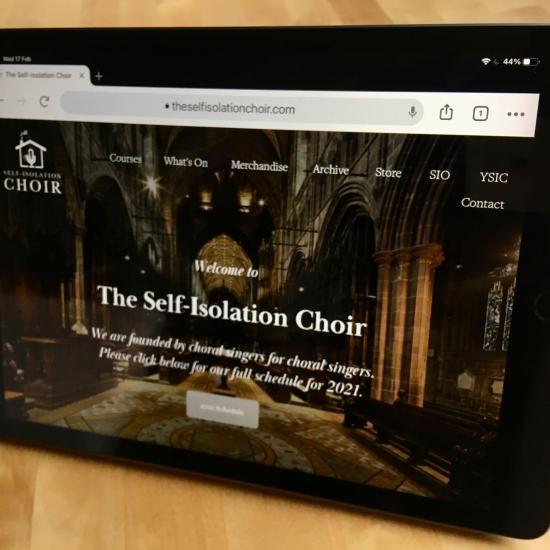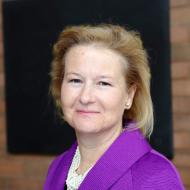In the shift from physical to virtual, at work and elsewhere, we have learned much about how organisations might work better in future - and how to lead them.
Those lessons may have come from the resilience of big corporates, from the energy of community groups, or from the innovation flourishing in arts organisations. And now is the time to absorb these new insights, as we start to grapple with our collective challenge to construct the next normal.
Choral singers around the world have got together to form online choirs, while almost all same-room choirs are suspended, and in doing so they have created a new art form. They have brought remote, repeatable teaching and recording facilities to thousands of singers, blended into global live performances streamed on YouTube, sometimes with hundreds of voices joining in, each singing alone from their kitchen.
The Self-Isolation Choir, founded by Mark Strachan in the UK a year ago in response to pandemic lockdown restrictions, now has more than 12,000 singers worldwide. It has made multiple recordings and CDs and runs an annual summer school. Its members recently performed a virtual ‘world tour’ of Mendelssohn’s Elijah, with three performances in one day for singers across different time zones.
These are new kinds of online communities - exclusively digital - bringing together singers who have never met and don’t even live in the same time zones. What does their experience tell us about how the nature of organisations and leadership is changing? The success story of the Self-Isolation Choir illustrates some of the ingredients we will need in post-pandemic organisations, whether digital or hybrid. Here are six lessons we can learn.
1. Collaborating as individual, expert leaders
Research insights underline that we will need every bit of our collective intelligence and insight to rebuild our next normal, and what will matter is a leader’s ability to create a context in which everyone can lead; leadership becomes less about one individual, and more about a ‘shared property of the wider system in which the leader operates.’
The example of the Self-Isolation Choir shows what this could look like in practice. In a physical, same-room choir, there will usually be a single conductor and perhaps a voluntary or part-time administrative manager. In the digital world, there is a variety of roles, each with critical expertise to contribute: musicians, sound engineers, web designers and broadcast experts.
The leadership team has broadened, given the choir’s rapid growth rate: on day one of its existence, over a thousand singers had signed up, and by the end of the first course, a few weeks later, there were 3,000. Now there are many more. But the feeling of connectedness which is so important to the singers is visible in the leadership too - especially in the style of interaction with choir members. For example, professional soloists often join the online chat at performances, to respond to questions or comments; sound engineers produce videos explaining what they do.
The organisational arrangements which support them are not hierarchical but flat, and they fluctuate as different courses and performances are offered and as new ideas are implemented.

2. Setting a context for innovation to flourish
It was not obvious that the experience of singing in a large choir could be recreated digitally; after all, the main thing singers want from a choir - the aggregated sound, the feeling of singing together - was the one thing that Covid-19 rules prevented. The idea was turned into action by an experienced choral singer, Mark Strachan, who says he knew just enough about technology to feel the experiment was worth trying.
This willingness to try new things has become part of the culture of the organisation. Suggestions come from anyone and everyone involved: the choir’s founder, the musical director, the professional musicians and sound engineers, as well as from singers themselves.
Some innovations have been tried and discarded, but the organisation continues to foster the transfer of new ideas into action. The choir has diversified into an online orchestra which does for orchestral players what the choir does for singers. It has also established an internet radio station focused exclusively on choral music.
But although new and exciting developments have come to be characteristic of the organisation, the rate of innovation is controlled, so that the schedule of new courses and performances is manageable, both for the organisation and for its members.
3. Taking the initiative – acting at the right time
Timing can be everything. It was vital to set up the choir quickly at the start of the first lockdown in order to catch the interest of singers. It took only 30 minutes to interview and appoint the musical director, and two days later the first rehearsal was online. A willingness to implement ideas quickly has been a part of the choir’s success - and equally, a readiness to change the approach if it is not working well enough.
4. Taking decisions by instinct, but listening to feedback
Because this sense of timing is so important, instinct plays a large role in decisions, which often have to be made quickly. For example, the choir’s course schedules have been modified in response to events: feedback from singers altered the recording timetable and the huge success of a particular performance changed the planned repertoire.
...instinct has to be honed and fostered by feedback and communication.
The organisation’s structure is fluid enough to allow this decision-making to operate effectively – there is no committee to choose which works to sing, so it is easier to alter the selection quickly, in response to the mood of the membership.
But instinct has to be honed and fostered by feedback and communication. The choir’s founder places great emphasis on two particular tasks which other organisations might regard as trivial and administrative: he answers every single email he receives personally, briefly if necessary, and he himself acts as chat moderator during the online rehearsals broadcast on YouTube.
Both take considerable amounts of time, but they stimulate feedback – and allow leaders to understand how choir members are feeling, what is working well and what is not.
5. Fostering a sense of involvement
This level of feedback and response generates a strong feeling of involvement, unusual in an online community. This active participation is visible in the moderated chat during rehearsal; often, singers make suggestions for some new improvement, and then turn it into action.
The leadership in the organisation has generated a culture of respect for this collective intelligence.
Choir members have set up and now manage a Facebook group, and have designed and commissioned merchandise. Some members have developed a product for charity fund-raising; one member has produced a set of recorded warm-up tutorials and another has reset the music scores to make them easier to follow.
The choir’s connected feel is one of its great strengths, vital right now when so many are cut off from their communities and families. Thousands of singers across the world who have never met in person talk to each other on chat and social media as if they had.
The leadership in the organisation has generated a culture of respect for this collective intelligence, whether amateur or professional, whether singer, soloist or sound engineer, and this in turn allows rapid and decentralised problem-solving.
6. Sharing a common purpose
The whole endeavour - structures, styles of working, skills of those involved - is built around the choir’s fundamental purpose, set out on its website: ‘The Self-Isolation Choir aims to provide comfort and support to people feeling disconnected from family, friends and society by bringing us all together to sing glorious choral works.’
The choir's success is not about an individual leader - even its founder describes himself simply as “a fellow singer”. The choir has grown in scale, in reputation and in quality because of the leadership engendered in the organisation - from those who have a formal job as well as from choir members.
Thousands of singers have seen how well this kind of shared leadership in a digital community can work; our challenge now is to bring it into our working world.




